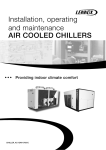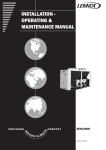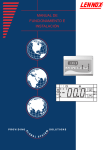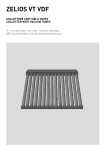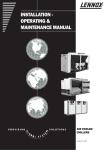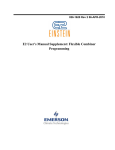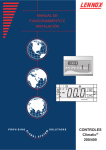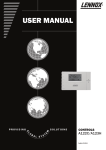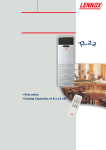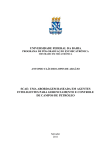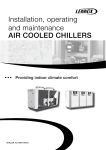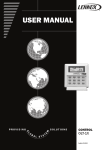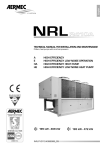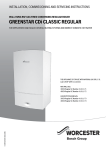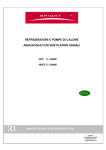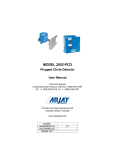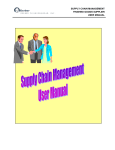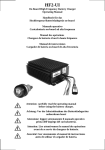Download CHILLER IOM
Transcript
INSTALLATION OPERATING & MAINTENANCE MANUAL CHILLERS LIST OF CONTENTS 1. DELIVERY OF EQUIPMENT ON SITE ........................................................ 3 1.1 VERIFICATION OF EQUIPMENT DELIVERED ..................................... 3 1.2 STORAGE ................................................................................................... 4 2. INSTALLATION ............................................................................................... 4 2.1 PRELIMINARY CHECKS ............................................................................ 4 2.2 LIFTING AND HANDLING ........................................................................... 4 2.3 UNIT PLACEMENT ...................................................................................... 4 2.4 WATER CONNECTIONS ............................................................................. 6 2.5 ELECTRICAL CONNECTIONS ................................................................... 7 2.6 SOUND LEVELS ......................................................................................... 7 2.7 UNITS MOUNTED ON RECEIVERS .......................................................... 8 3. START UP ...................................................................................................... 10 3.1 PRELIMINARY CHECKS......................................................................... 10 3.2 UNIT START UP ....................................................................................... 11 3.3 IMPORTANT ............................................................................................. 12 4. OPERATION ................................................................................................... 12 4.1 CLIMATIC CONTROL .............................................................................. 12 4.2 UNIT OPERATION ................................................................................... 12 5. MAINTENANCE ............................................................................................. 17 5.1 WEEKLY MAINTENANCE ....................................................................... 17 5.2 YEARLY MAINTENANCE ........................................................................ 18 5.3 CLEANING THE CONDENSER .............................................................. 19 5.4 COMPRESSORS / OIL DRAINAGE ...................................................... 19 5.5 IMPORTANT ............................................................................................. 19 6. TROUBLESHOOTING/ REPAIRS ............................................................... 20 6.1 LIST OF THE MOST COMMON PROBLEMS ...................................... 20 6.2 START UP CHECK SHEET .................................................................... 26 6.3 REGULAR INSPECTIONS TO BE MADE ............................................. 27 6.4 MANUFACTURERS RECOMMENDED INSPECTIONS ; RECIPROCATING COMPRESSOR ....................................................... 28 SCROLL COMPRESSOR ........................................................................ 30 SCREW COMPRESSOR ......................................................................... 32 CHECK LIST ....................................................................................................... 34 MES/GEN 1 2 MES/GEN 1. RECEPTION OF EQUIPMENT ON SITE 1.1 VERIFICATION OF EQUIPMENT DELIVERED 1.1.1 TRANSPORT Carriage of the equipment is at the risk and peril of the recipitent, and the latter is obliged, after delivery and unpacking, to : - Check the external appearance of the equipment, - Check the absence of any shock damage or deformation, 1.1.2 DELIVERY OF THE EQUIPMENT Upon delivery, the contractor must check that the equipment is in good condition and make sure that : - the lifting and handling gear is adapted to the configuration of the equipment and that it corresponds to the specifications indicated on the rigging label pasted on the machine. - the accessories ordered for site assembly have been delivered and are in good condition. - the equipment delivered corresponds with the order and with the list on the carrier's shipment documents - if the unit is delivered with its operating charge of refrigerant, that there has been no leakage (use an electronic detector). Please be reminded that the HCF LENNOX guarantee does not cover the refrigerant charge. In the event of any damage, make precise and justifiable claims by registered mail to the transport company within 48 hours of delivery (the day of delivery and bank holidays are not counted in this delay). A copy of this letter should be addressed to HCF LENNOX and the sales agent or distributor so as to inform them. Failing this, no action can be taken against the transport company. 1.1.3 UNIT NAMEPLATE This shows the complete reference number of the model and enables you to check that the unit corresponds with what was ordered. Unit current draw at start up, nominal current, and unit power supply are also indicated. The latter must not be exceeded by +10/-15 % . Current draw at unit start up is the maximum value likely to be attained at the operating voltage indicated. The customer's electrical installations must be able to withstand this current. It is therefore important to make sure that the unit power supply shown on the unit nameplate agrees with available voltage. MES/GEN 3 1.2 STORAGE When the units are delivered on site, they are not always started up immediately and are placed in storage. If the units are stored for a medium or long period of time, we recommended the following : - To make sure of the total absence of water in the water circuits, - To keep the coil protection installed. - To leave the protective plastic sheets in place. - To make sure that the electrical boxes are tightly closed. - To keep any components delivered separate for site assembly indoors, in a clean and dry place, until unit start up. It is strongly recommended to store units is a dry, sheltered place (in particular for units that will be installed indoors). 2. INSTALLATION 2.1 SAFETY INSTRUCTIONS Installation, start up and adjustment of this equipment can be dangerous if certain system specific factors are ignored, such as operating pressures, electrical components, locations (roofs, terraces and other structures located well above ground level). Only highly qualified contractors and technicians with sound knowledge of this type of equipment, are authorised to install, start up and service it. During any service operations, observe the recommendations given on labels or instructions sent with the equipment, as well as any other applicable safety procedures. - Follow all safety rules and regulations - Wear protective glasses and work gloves - Handle heavy or bulky equipment carefully during lifting and moving operations, and when setting it on the ground. CAUTION : BEFORE EACH SERVICE OPERATION MAKE SURE THAT THE UNIT POWER SUPPLY IS PROPERLY SHUT OFF AND LOCKED OUT. 2.2 HANDLING Handling operations must be carried out by qualified personnel. Comply strictly with lifting instruction pasted on the unit. Unit handling operations must be carried out carefully to avoid jolting the frame, the panels, the electrical box, the condenser coil fins, etc.... 2.3 UNIT PLACEMENT Before placing the unit, check the following points : - Strength, flatness, water-tightness of the concrete flooring slab. - That there is sufficient free space around and above the unit for proper airflow as indicated on the unit dimensional drawings. - The number of pressure points and their locations. 2.3.1 STRENGTH OF THE FLOORING SLAB The ground beneath the unit must be flat, level and of sufficient strength to support the weight of the unit with its full liquid charge, and the occasional presence of the usual service equipment. It must be rainproof and very rigid to avoid loss of water-tightness due to any eventual deformation. 4 MES/GEN In locations exposed to frost, the supporting surface, if the unit is installed on the ground, must be built on concrete stakes extending downwards beyond the normal depth of frost. It is always advisable to build a supporting surface detached from the general building structure to avoid transmission of vibrations. 2.3.2 VIBRATION ISOLATORS On normal applications, unit rigidity and pressure point spacing enables installation without nuisance vibration. Vibration isolators may be used by contractors on installations requiring particularly low vibration levels. Use of vibration isolators MUST be accompanied by installation of flexible connections in the unit water piping. Vibration isolators must also be fixed to the unit BEFORE being fixed to the ground. Selection of isolator vibration absorbing capacity is not HCF LENNOX's responsibility. The unit must be bolted to the vibration isolators and the latter solidly fixed into the concrete slab. Check that vibration isolator contact surfaces fit flush to the floor. If necessary, use spacers or re-surface the flooring, but in all events, make sure that the isolators seat flatly on the supporting surface. 2.3.3 CLEARANCES REQUIRED It is essential that the units be installed with sufficient free space around them to enable proper circulation of air ejected by the condensers and to provide easy access to all unit components for servicing and maintenance. If the air rejected by the condenser encounters any obstacles, it will tend to be recycled by the fans. This will cause an increase in the temperature of the air used to cool the condensers. Obstruction of the air outlet will also impair air distribution across the entire heat exchanging surface of the condenser. Both of these conditions, which reduce the heat exchange capacity of the coils, will cause an increase in condensing pressure. This will lead to a loss of capacity and an increase in compressor power input. To prevent air flow to be reversed due to prevaling winds, units cannot be completely shrouded with a higher, uninterrupted wind shield. If such a configuration cannot be avoided, an air ejection duct must be installed up to the same height as the surrounding sheild. Unit dimensional drawings enable the optimum position of the units to be determined both for installation and maintenance MES/GEN 5 2.4 WATER CONNECTIONS 2.4.1 WATER CONNECTIONS - EVAPORATOR The water circulating pump must be installed upstream so that the evaporator will be subjected to positive pressure. Entering and leaving water connections are indicated on the certified drawing sent with the unit or shown in the sales brochure. A drainage plug is located at the base of the evaporator. A drainage pipe may be connected to this to enable drainage of evaporator water for service operations or for seasonal shut down. If the unit uses plate type heat exchangers, the use of a water filter in the water circuit upstream of the heat exchanger is mandatory. These filters must remove all particles with a diameter greater than 1 mm. They may be supplied as an option by the manufacturer. 2.4.2 WATER ANALYSIS The water must be analysed ; the water circuitry installed must include all items necessary for treatment of the water : filters, additives, intermediate exchangers, bleed valves, vents, isolating valves etc... according to the results of the analysis. We do not advise operation of the units with open loops which can cause problems with oxygenation, nor operation with untreated ground water. Use of untreated or improperly treated water can cause deposits of scale, algae and sludge or cause corrosion and errosion. It is advisable to call in a qualified water treatment specialist to determine what kind of treatment will be necessary. The manufacturer cannot accept liability for damage caused by the use of untreated or improperly treated water, salt water or brine. 2.4.3 ANTIFREEZE PROTECTION a) Use glycol/water solution ADDITION OF GLYCOL IS THE ONLY EFFICIENT WAY TO PROTECT AGAINST FREEZE-UP The glycol/water solution must be sufficiently concentrated to ensure proper protection and prevent formation of ice at the lowest outdoor air temperatures expected on an installation. Take precautions when using non passivated MEG antifreeze solutions. Corrosion can occur with these antifreeze solutions in the presence of air. b) Drain the installation It is important to make sure that manual or automatic air bleeders are installed at all the high points of the water circuit. To enable drainage of the circuit, make sure that drain cocks are installed at all the low points of the circuit. To drain the circuit, the drain cocks must be opened and an air inlet ensured : air bleeders are not designed to admit air. FREEZE UP OF AN EVAPORATOR DUE TO COLD WEATHER CONDITIONS CANNOT GIVE RISE TO A WARRANTY CLAIM. 2.4.4 ELECTROLYTIC CORROSION We would like to draw your attention to the problems of corrosion due to electrolytic corrosion caused by an imbalance between earthing points. AN EVAPORATOR THAT IS PUNCTURED BY ELECTROLYTIC CORROSION IS NOT COVERED BY THE UNIT WARRANTY 2.4.5 MINIMUM WATER CAPACITY The minimum volume of the chilled water circuit must equal 10 % of the volume of water circulating per hour through the unit. If necessary, install a buffer tank. Proper operation of regulating and safety devices can only be ensured if the volume of water is sufficient. 6 MES/GEN 2.4.6 FLOW SWITCH A flow switch must be installed on the evaporator water inlet or outlet, so as to enable detection of water flow through the heat exchanger before the unit is started up. This will protect the compressors against any eventual liquid slugging during the starting phase and prevent accidental ice formation in the evaporator, if the flow of water is interrupted. Flow switches are available on option. The normally open contact of the flow switch should be connected to the terminals provided to that effect in the unit electrical box. (See the wiring diagram supplied with the unit). The normally closed contact can be used as an indication of a lack of flow condition. 2.5 ELECTRICAL CONNECTIONS First of all, make sure that power supplies from the building to the place where the unit is installed are properly established and that wire gauges are in keeping with the start up and running currents. Check tightness of all electrical connections. You MUST make absolutely certain that the power supplies applied to the power and control circuits are those for which the electrical panel was manufactured. A main isolator switch must be inserted between the end of the power supply cable and the unit to enable total isolation of the latter when necessary. Chillers are supplied as standard without a main isolator switch. This is available as an option. CAUTION 1) Wiring must conform to applicable regulations. The type and location of fused isolators must also conform with regulations. For the sake of safety, install them where they can be seen and in easy reach of the unit. 2) A back up power supply is provided for the crankcase and antifreeze heaters. This power supply is independent from the main unit. IMPORTANT Operation of a unit with the wrong power supply or with excessive phase imbalance constitutes abuse and is not covered by the HCF LENNOX warranty. If phase imbalance exceeds 2 % for voltage and 1 % for current, contact your local electricity company immediately before powering up the unit. 2.6 SOUND LEVELS Liquid chillers are a significant source of noise in refrigeration and air conditioning systems. Account is taken of technical constraintes, both in design and manufacturing, sound levels cannot be be improved much further than specified. Sound levels must therefore be accepted for what they are, and the area surrounding the chillers should be treated as necessary. The quality of installation can either improve or decrease initial sound characteristics: it may be necessary to provide further treatment such as sound-proofing or installation of screens around units installed externally. The choice of the location for the installation can be of great importance : reflection, absorption, transmission of vibrations. The type of unit support is also very important : inertia of the room and the structure of the walling, interfere with the installation and its behaviour. Before taking any other steps, first determine whether the sound level is compatible or not with the environment, what it is perfectly justifiable and that these measures envisaged will not cause unreasonable cost. Determine what level of sound proofing is necessary on the equipment, the installation (silencer, vibration isolators, screens) and on the building (reinforcement of flooring, false ceilings, wall coverings). It may be necessary to contact an engineering office that specialises in sound abatement. MES/GEN 7 2.7 UNITS MOUNTED ON RECEIVERS 2.7.1 CONNECTION OF UNITS ON RECEIVERS Connections between the unit and the condenser must be made by a qualified refrigeration engineer and require several important precautions. In particular, the shape and dimensions of the hot gas lines must be carefully designed to ensure proper oil return in all cases and prevent liquid from returning into the cylinder heads when the compressor is stopped. On units fitted with capacity reducers, the piping sizes must be caculated so that gas velocity is sufficiently high when the unit is operating on capacity reduction. Non application of these precautions will cancel the compressor warranty. a) Liquid line Determine the size of liquid lines using : 1) Operating conditions at full load. 2) Maximum pressure drop of 100 kPa 3) Liquid velocity under 3m/s (to avoid liquid slugging). 4) For liquid risers, make sure that liquid subcooling is sufficient to counteract the loss of static pressure and prevent gas flashing. b) Discharge lines Calculate these to obtain a gas velocity in horizontal and vertical sections that enables compressor oil migration and steady return to the compressor. Determine the dimensions of liquid lines using : 1) 2,5 m/s minimum in horizontal sections 2) 5,0 m/s minimum in vertical sections 3) Maximum velocity 15 m/s. 4) Total load loss in the piping lower than or equal to 1°C at saturation pressure c) Mechanical isolation of refrigerant lines Isolate refrigerant lines from the building to prevent the vibrations normally generated by the lines to the building structure. Avoid bypassing the isolation system on the unit by fixing refrigerant lines or electrical conduits too tightly. Any vibrations will be transmitted to the building by rigid piping. 2.7.2 INSTALLATION a) Pressure test To avoid formation of copper oxide during brasing operations, blow a little dry nitrogen through the pipes. Piping must be made with tubing that is perfectly clean, plugged during storage and between connection operations. During these operations, observe the following precautions : 1) Do not work in a confined atmosphere, refrigerant fluid can cause fainting. Make sure there is sufficient ventilation. 2) Do not use oxygen or acetylene instead of refrigerant fluid and nitrogen for leak testing : this could cause a violent explosion. 3) Always use a regulator valve, isolating valves and a pressure gaUges to control test pressure in the system. Excessive pressure can cause lines to burst, damage to the unit and/or cause an explosion with severe personal injury. Ensure conduct liquid line and gas line pressure tests are in conformity with applicable legislation. Before starting up a unit on a receiver, the piping and the condenser must be dehydrated. Dehydration should be carried out using a double stage vacuum pump, capable of drawing 5 mmHg absolute pressure vacuum. 8 MES/GEN Best results are obtained with a vacuum down to 1 mmHg. To get down to this level at normal temperatures, i.e. 15 °C, it is often necessary to leave the pump running for 10 to 20 hours. The duration of pump operation is not a factor of efficiency. The pressure level must be checked before the unit is put into service. b) Charge Chiller units can be charged either in the liquid phase or in the vapor phase. In liquid phase, connect either to a liquid isolating valve, or to the quick-connector on the liquid line at the valve outlet ; In the vapor phase, connect up to the suction valve. Never charge a machine operating on R407C in the vapour phase (vapor) : the composition of the mixture could be modified. Note : Units mounted on receivers are supplied with a refrigerant/nitrogen holding charge. Before pulling down the vacuum for dehydration, completely purge the unit. Charge the unit until there is a constant flow of bubble-free liquid in the sight-glass indicating that there is sufficient charge and that subcooling is correct. In all cases, do not top up the charge until the unit reaches a stable state of operation. It is pointless to overcharge a system, this can adversely affect operation. Overcharging causes : 1) Excessive discharge pressure, 2) A risk of damage to the compressor, 3) Excessive power consumption. c) Oil charge All units are delivered with a complete oil charge. In the case of units mounted on receivers, it may be necessary, due to the length of piping installed, to add a certain amount of oil compatible with the type of compressor and refrigerant used. d) Air cooled condensers An air cooled condenser connected to a unit must have the same number of circuits as the unit. Selection of the condenser must be made carefully to enable transfer of the heat capacity of the unit even at the highest temperatures expected on an installation. e) Head pressure control A system has to be envisaged to enable the unit to operate whatever the season. A variety of different systems may be used, but the most simple and efficient of these modulates fan operation using a pressure or temperature control. On condensers fitted with a small number of fans (1 or 2), it may be necessay to vary the speed of the fans. Head pressure control systems that operate by flooding the condenser with liquid refrigerant should be avoided since they entail very large refrigerant charges and can cause serious problems if they are not correctly controlled. MES/GEN 9 3. START UP 3.1 PRELIMINARY CHECKS Before proceeding with start up, even for a test of short duration, check the following points, after having made sure that all the valves on the refrigeration circuit are fully open (discharge valves and liquid valves). Starting up a compressor with the discharge valve closed will either trip the HP safety switch, or blow the cylinder head gasket or the internal pressure safety disc. 1) The liquid pump(s) and other apparatus interlocked with the unit (coils, air handling units, dry coolers, cooling towers, terminals such as fan coil units, etc.) are in working order as required by the installation and according to their own specific requirements. Place all water valves and refrigerant valves in their operating positions and start the water circulating pumps. 2) Make sure that the power supplied to the unit corresponds to its operating voltage and that phase rotation corresponds to the direction of rotation of the compressors (screw & scroll). 3) Make sure that the water circuits mentioned in 1 are completely filled with water or brine as the case may be; with the air bled out of all high points, including the evaporator ensuring they are perfectly clean and leaktight. In the case of machines with water cooled condensers, the condenser water circuit must be ready to operate, filled with water, pressure tested, bled, filter cleaned after 2 hours of operation of the water pump. Cooling tower in operating condition, water supply and overflow checked, fan in operating condition. 4) Check the cleanliness and the tightness of all electrical connections, both the connections made at the factory and the connections made on site. Also make sure that all thermostat bulbs are correctly inserted and tightened in the various wells, if necessary add heat conducting paste to improve contact. Make sure all sensors are correctly fitted and that all capillary tubes are fastened. The technical data printed at the top of the wiring diagram should correspond with those indicated on the unit nameplate. 5) Reset all manually resetting safety devices (where necessary). Open power circuits to all components: compressors, fans.... 6) Power up the unit with the main disconnect switch (option). Visually check the oil level in the compressor crankcases (bullseyes). This level may vary from one compressor to another, but should never be higher than the first third of the way up the bullseyes. CAUTION : Power up the compressor crankcase heaters at least 24 hours before starting the unit (as standard, this 230 V backed-up power supply is user installed). This will enable the refrigerant in the crankcases to evaporate off, and prevents damage to compressors through lack of lubrication during start up. 7) Start the pump(s) check the flow of liquid to be cooled through the heat exchangers : note the inlet and outlet pressures of the latter, and, using the pressure drop curves, calculate liquid flow by applying the following formula: actual flow Q2 = Q1 X P2 P1 where P2 = pressure drop measured on site P1 = pressure drop published by HCF LENNOX for a liquid flow of Q1 Q1 = nominal flow 10 MES/GEN 8) On units with air cooled condensers, check for correct operation of the fans and that the protective grilles are in good condition. Make sure that rotation is in the right direction. 9) Before making any electrical connections, check that insulation resistances between power supply connection terminals is in keeping with applicable regulations. Check the insulation of all electrical motors using a DC 500V megohmeter, following the manufacturer's instructions. CAUTION: Do not start any motor whose insulation resistance is lower than 2 mégaohms. Never start any motor while the system is under a vacuum. 3.2 UNIT START UP 3.2.1 CHECKS TO BE MADE DURING START UP Before starting the unit, fill in the check sheet on page 34 of this manual and follow the instructions below to be sure that the unit is correctly installed and ready to operate. 1) Thermometers and pressure switches installed in the chilled water circuit and the condenser water circuit. Check these safety devices in this order: high pressure switch, differential oil pressure switch, low pressure switch, fan control pressure switches and thermostats, anti short cycle relay. Make sure all indicator lights operate correctly. 2) Flow switch installed and wired into the control box. 3) With the compressor running, check the oil pressure. If there is a fault, do not restart the compressor again until the source of the problem has been located. 4) Check that there is sufficient cooling load on the day the start up is conducted (at least 50 % of the nominal load). PROCEDURE TO FOLLOW WHEN STARTING THE UNIT a) Press the power "ON-OFF" switch. The compressor will only start if the evaporating pressure is greater than the cut-in set point of the low pressure switch. Evaporating pressure drops steadily, the evaporator empties itself of the liquid refrigerant accumulated in it during storage. After a few seconds, the solenoid valve opens. b) Check on the sightglass (upstream of the expansion valve) that the bubbles disappear progressively, indicating a correct refrigerant charge and the absence of noncondensibles. If the humidity indicator changes colour, indicating the presence of humidity, replace the filter-drier cartridge if the latter is of the replaceable type. c) Check that, when the cooling load has been balanced by the capacity of the unit, the chilled liquid is at design temperature. 5) Check the current values per phase on each compressor motor. 6) Check the current values per phase on each fan motor. 7) Check compressor discharge temperature. 8) Check compressor oil pump temperatures (semi-hermetic reciprocating compressors). 9) Check suction and discharge pressures and compressor suction and discharge temperatures. 10) Check chilled liquid entering and leaving temperatures. 11) Check outdoor air temperature. 12) Check liquid refrigerant temperature at the condenser outlet. MES/GEN 11 These verifications should be made as quickly as possible with a stable cooling load, i.e. the cooling load of the installation should be the same as the capacity developed by the unit. Measurements taken without heeding this condition will result in unuseable and probably wrong values. These verifications can only be made once the proper operation of all safety devices and unit controls has been established. 3.2.2 OIL CHARGE Units have a complete operating charge of oil when they are shipped, and there is no need to add any oil before start up or afterwards. Note that unit shutdowns by the differential oil pressure switch are usually caused by other problems than a lack of oil in the refrigeration circuits. Overcharging with oil can cause serious problems on an installation, particularly for the compressors. The only time any oil might need adding is when a compressor is replaced. 3.2.3 REFRIGERANT CHARGE Self-contained units have a complete refrigerant charge at the time they are shipped. This charge may need to be topped up when the unit is installed or at other times during the service life of the unit. Additional charge can be introduced through the Schrader valves on the suction line. Every time fluid is added, check the state of the charge with the sightglass provided to that effect on the liquid line and also by the amount of liquid subcooling at the condenser outlet. 3.3 IMPORTANT - Start up and commissioning must be conducted under the supervision of a refrigeration expert. - Never shut of power to the crankcase heaters except for lengthy service operations or seasonal shutdown. Remember to power up the crankcase heaters at least 24 hours before the unit is restarted. 4. OPERATION 4.1 CLIMATIC CONTROL cf. See the specific CLIMATIC manual cf. See the specific MASTERTECH manual for PRA units 4.2 UNIT OPERATION 4.2.1 FUNCTIONS OF REFRIGERATION CIRCUIT COMPONENTS Thermostatic expansion valve : Very important: The thermostatic expansion valve fitted on each machine has been selected for a given operating range ; it must be replaced with a model with the same reference from the same manufacturer. Filter-drier : This is designed to remove all traces of humidity from within the refrigeration circuit, since this can impair operation of the unit, by acidification of the oil, which causes slow disintegration of the varnish protecting the compressor motor windings. High and low pressure gauges (option) : Enables istantaneous readout of suction and discharge pressures. Sightglass/humidity indicator: (optional on units fitted with scroll type or reciprocating compressors) : - Enables visual verification of the state of the liquid refrigerant (monophase ou diphasic) in the liquid line, upstream of the thermostatic expansion valve. - Enables detection of humidity in the circuit. 12 MES/GEN Crankcase heater: Every compressor is fitted with a single phase crankcase heater that is activated when the compressor stops to ensure separation of the refrigerant and the compressor oil. It is therefore powered up when the compressor is not running. NB : MANEUROP Scroll and reciprocating +6°C ambient type compressors are not fitted with a crankcase heater. High pressure switch : This pressostat initiates unconditional stoppage of the unit if compressor discharge pressure exceeds the operating limits. Reset is automatic. Low pressure switch: This pressure switch initiates unconditional stoppage of the unit if if evaporating pressure drops below the value P. - 1) +6°C ambient temperature machines (standard) P = 2,4 bars relative - 2) optional -20°C ambient temperature machines P = 0,8 bars relative Fan control pressure switch and thermostat: The function of these devices is to ensure a level of head pressure compatible with proper unit operation. An increase in outdoor air temperature increases head pressure, and this is maintained at its required value by fan operation ; or by fan stoppage if the temperature decreases. Antifreeze function: This function only exists on units designed for brine or glycol/water chilling for which the freezing temperature depends on the concentration of the solution. Whatever type of device is used (see case 1 and 2), cut-out by the antifreeze function causes immediate unit stoppage. Antifreeze thermostat (option) : This device monitors chilled liquid temperature at the evaporator outlet. It triggers when the temperature goes below the minimum value (+ 4°C for water). CASE 1 : CASE 2 : Antifreeze pressure switch (option) : This monitors evaporating pressure of the refrigerant. It triggers when the temperature goes below the preset minimum value. Note : On units fitted with CLIMATIC or MASTERTECH controls, see the appropriate user manual for more specific details. Differential oil pressure safety switch : (only on units with semi-hermetic compressors) a) Reciprocating compressors : This pressure switch initiates unconditional unit stoppage if differential oil pressure drops for more than two minutes below a preestablished minimum safety value. Differential oil pressure is the difference between the oil pump discharge pressure and the gas pressure inside the compressor crankcase (suction pressure). The differential oil pressure safety switch is factory set and is not modifiable on site. b) Screw compressors: This pressure switch initiates unconditional unit stoppage if differential oil pressure rises above a preset safety value. Differential oil pressure in this case is high pressure less the compressor oil injection pressure. 4.2.2 FUNCTIONS OF ELECTRICAL COMPONENTS Electronic or cam type anti-short cycle relay : This device limits the number of compressor start ups. Compressor motor thermal protection : This device stops the motor if winding temperature rises too high and enables it to start up again when temperature drops back to a normal value. MES/GEN 13 Fan overcurrent protection: Circuit breaker designed to stop the fan motors in the event of phase overcurrent in relation to the permitted value. Compressor motor overcurrent protection : Circuit breaker designed to protect each motor winding against accidental overcurrent. Indicator lights: The electrical control box is fitted with indicator lights enabling visualisation of the state of operation or non operation of a function or given circuit. There is also an indicator to show that the unit is powered up, an emergency stoppage indicator for each compressor, an indicator to show stoppage of the compressor via the regulating system (through the main control thermostat which is sensitive to chilled water temperature), a run light per compressor, and a general fan default stoppage indicator (on air cooled units). On units with CLIMATIC or MASTERTECH controls, see the appropriate manual. Time delay relay for starting compressor motors one winding at a time (option) : This optional relay is supplied on units ordered with the part winding start system. The time delay between starting the first winding and the second winding cannot exceed 0.8 seconds. Chilled liquid pump interlock: This interlock is made only if the the pump is supplied with the liquid chiller. As soon as the unit is powered up and the remote on/off for the unit is validated, the pump starts running. Prior operation of the pumps is mandatory for compressor operation. Note : on units with CLIMATIC control, control of 1 or 2 water pumps is catered for by the control program. Flow switch for the chilled liquid (option) : This control device initiates unconditional unit stoppage as soon as the flow of chilled liquid (water, brine, etc...) ensured by the pump becomes insufficient, since this could cause rapid evaporator freeze up. When the contact opens due to a lack of flow the unit must stop immediately. If the purchaser installs a flow switch himself, electrical connections should be made to the two remote interlock terminals (dry contact). 4.2.3 AUTOMATIC SEQUENCES Starting sequence: - press the unit start switch, the power light will come on ; The control circuit cannot be energised if there is no power supply to the main power circuit. - Depending on the demand for cooling, the control thermostat authorises start up of the compressor(s), which takes place in cascade. The compressor run indicating lights come on. Regulator stoppage sequence : When the cooling load starts decreasing from its maximum value, the multi-stage control thermostat shuts down successive stages depending on the progressive reduction in return chilled liquid temperature. Depending on machine equipment, staged reduction consists either in shutting down a compressor or activation of a compressor capacity reducer. This continues until the unit shuts down completely through action of the regulator. The compressor regulation stoppage lights come on. Safety shutdown sequence : If a default occurs on a circuit, it is detected by the appropriate safety device, (high pressure overshoot, loss of oil pressure, motor protection, etc...) The relay in question initiates unconditional stoppage of the compressor on that circuit and the safety stoppage indicating light comes on. Some defaults give rise to immediate stoppage of the entire unit : Tripped flow switch, Tripped antifreeze thermostat ...etc.... In cases other than that of manually reset safety devices, starting up of the circuit or the machine takes place automatically once the default has been cleared. 14 MES/GEN Loss of power supply : There are no problems restarting the machine after a loss of power supply of short duration (up to about one hour). If loss of power supply lasts longer than this, when power supply is resumed set the unit to "OFF" with the compressor crankcase heaters activated for as long as it takes to bring sump oil back up to temperature, then restart the unit. Pressostatic water valve : This device is available as an option for low capacity water cooled condensing units (PLCW, RLZ units). The pressostatic water valve should be installed on the condenser outlet. It enables water flow through the heat exchanger to be varied so as to maintain condensing pressure at an appropriate value. Fan motor control: The product ranges concerned are those not equipped with CLIMATIC control as standard equipment: PLCA D RLA SV/DV GCA SV/DV GCAD PRA PLCA DC RLA SC/DC GCA SC/DC GCA DC PRA C Meanings of the abbreviations above : Vn : Fan n Pvn : Low fan speed (fan n) Gvn : High fan speed (fan n) PHP1 : HP pressure switch P100 cuts in at 15,5 bars / cuts out at 10,3 bars PHP2 : HP pressure switch P100 cuts in at 17,2 bars / cuts out at 11,7 bars PHP3 : HP pressure switch P100 cuts in at 19 bars / cuts out at 13,5 bars I) Self-contained units designed for + 6°C ambient Number of fans per circuit 1 2 3 4 750 rpm fans 750/500 rpm fans 1 single speed 750/500 rpm motor PV1 directly with the compressor GV1 on PHP1 500 rpm fans V1 on PHP1 2 750 rpm motors V1 directly with the compressor V2 on PHP1 V1 directly with the compressor V2 on PHP1 3 750 rpm motors V1 directly with the compressor V2 on PHP1 V3 on PHP2 V1 directly with the compressor V2 on PHP1 V3 on PHP2 4 750 rpm motors V1 directly with the compressor V2 on PHP1 V3 on PHP2 V4 on PHP3 V1 directly with the compressor V2 on PHP1 V3 on PHP2 V4 on PHP3 5 750 rpm motors V1 & V2 directly with the compressor V1 & V2 directly with the compressor V3 on PHP1 V4 on PHP2 V5 on PHP3 V3 on PHP1 V4 on PHP2 V5 on PHP3 5 MES/GEN 15 II) Self-contained units designed for - 20 °C ambients Number of fans per circuit 750 rpm fans 750/500 rpm fans 500 rpm fans 1 dual speed 750/500 rpm motor PV1 on PHP1 GV1 on PHP2 Fan speed controller mandatory 1 750/500 rpm + 1 750 rpm motor PV1 on PHP1 GV1 on thermostat V2 on PHP2 V1 with fan speed controller V2 on PHP1 3 1 750/500 rpm + 2 750 rpm motor PV1 on PHP1 GV1 on thermostat V2 on PHP2 V3 on PHP3 V1 with cp and on thermostat V2 on PHP1 V3 on PHP2 4 4 750 rpm motors V1 with cp and on thermostat V2 on PHP1 V3 on PHP2 V4 on PHP3 V1 with cp and on thermostat. V2 on PHP1 V3 on PHP2 V4 on PHP3 5 5 750 rpm motors V1 & V2 with cp and on thermostat V3 on PHP1 V4 on PHP2 V5 on PHP3 V1 & V2 with cp and on thermostat V3 on PHP1 V4 on PHP2 V5 on PHP3 1 2 On PRA units :propeller fans 640 rpm. or 940 rpm. Fans speeds vary from 0 to 100% depending on condensing temperature. PRA units with centrifugal fans: Fan speed is all-or-nothing depending on condensing temperature III) Condensing units for +6°C or -20 °C ambient temperature On condensing units, fans are all single speed whatever type of operation is envisaged (+6°C or -20°C) and what ever type of fan is used (750 tr/min or 500 tr/min). Each fan is controlled by an automatic, adjustable pressure switch. IV) Other cases a) Heat recovery In heat recovery mode, fan control on +6 or-20°C units described above is bypassed. All fan stages are therefore controlled by automatic, adjustable pressure switch. Cut-in points on these pressure switches should be adjusted so that fan operation enables leaving hot water temperature to be maintained at the value required. b) Desuperheating Controls described in § I,II,and III are used. 16 MES/GEN 5. MAINTENANCE The following maintenance instructions form a part of the operations required for this type of equipment. However, It is not possible to give fixed and precise rules for permanent maintenance procedures capable of keeping all units in perfect operating condition since too many factors depending on local conditions specific to the installation, the way the machine is operated, the frequency of operation, climatic conditions, atmospheric pollution, etc. Only trained experienced personnel can establish strict maintenance procedures adapted to the conditions listed above. Nonetheless, we recommend a regular maintenance schedule : - 4 times a year for chillers operating all year long - 2 times a year for chiller that only operate during the cooling season All operations must be performed in conformity with the maintenance plan; this will extend the service life of the unit and reduce the number of serious and costly breakdowns. It is essential to keep a "service log", for weekly records of operating conditions of the machine. This log will serve as an excellent diagnostic tool for maintenance personnel ; likewise, the machine operator, by noting down changes in machine operating conditions, will often be able to anticipate and avoid problems before they actually occur or worsen. The manufacturer cannot be held responsible for any malfunctioning of any equipment it provides if it is caused by a lack of maintenance or by operating conditions beyond those recommended in this manual. Shown below, and as an illustration only, are some of the most common rules applied for maintenance. 5.1 WEEKLY MAINTENANCE 1) Check the compressor oil level. This should be half way up the sightglass with the machine running at full load. Let the compressor operate for 3 to 4 heures before adding any oil. Check the oil level every 30 minutes. If the level does not reach the level indicated above, contact a qualified refrigeration mechanic. TYPE OF OIL RECOMMENDED BY HCF LENNOX(*) Comp. Reciprocating Copeland Reciprocating Maneurop Scroll Maneurop Screw Kobe R22 3G5 Suniso 160P Maneurop 160P Maneurop PU 3ON Kyoseki R134a Mobil Maneurop Maneurop Emkarate or R407c EAL Arctic 22 160P 160SE 160SZ RL220H Refrig. (*) This table is valid for self-contained chillers only (or chillers mounted on receivers) on which the leaving water temperature is not lower than -5°C. For other cases, consult the documentation shipped with the machine 2) Overcharging with oil can be as dangerous to a compressor as a lack of oil. Before topping up, contact a qualified technician. Only use oils recommended by the manufacturer. 3) Check the oil pressure. 4) The flow of liquid refrigerant through the sightglass should be steady and without bubbles. Bubbles are a sign of a low charge, a possible leak, or of a restriction in the liquid line. Contact a qualified technician. MES/GEN 17 Each sightglass is fitted with a humidity indicator. The colour of the element changes according to the level of humidity in the refrigerant, but also according to temperature. It should indicate "dry refrigerant. If it shows "wet" or "CAUTION", contact a qualified refrigeration technician. CAUTION : When starting up the unit, run the compressor for at least 2 hours before taking a humidity reading. The humidity detector is also sensitive to temperature, and as a consequence, the system must be at normal operating temperature to give a meaningful reading. 5) Check operating pressures. If they are higher or lower than those recorded when the machine was put into service, see the chapter on "operating incidents" p. 20 to 25. 6) Inspect the entire system so as to detect any eventual abnormality: noisy compressor, loose casing panels, leaky pipes or juddering contacts. 7) Record temperatures, pressures, dates et times and any other observations in the service log. 5.2 ANNUAL MAINTENANCE On units with water cooled condensers, it is important that the unit be serviced regularly by a qualified technican, at least once every year or every 1000 hours of operation. Failure to observe this rule can lead to cancellation of the warranty and will clear HCF LENNOX of whatever responsibility. A service visit by a qualified technician is also recommended after the first 500 hours of operation after the unit is first put into service. 1) Inspect valves and piping. Clean the filters if necessary, clean the condenser tubes (see "cleaning the condenser"). 2) Clean the chilled water piping filters. CAUTION: The chilled water circuit may be pressurised. Observe the usual precautions when depressurising the circuit before opening it. Failure to observe these rules could lead to accidents and cause injury to service personnel. 3) Clean any corroded surfaces and repaint them. 4) Inspect the chilled water circuit for any signs of leakage. Check operation of the water circulating pump and its ancillaries. Check the percentage of antifreeze in the chilled water circuit, top up as necessary (if antifreeze is used). 5) Carry out all weekly maintenance duties. The first and last inspection will include the seasonal shutdown procedure or the restarting procedure depending on the case. These inspections should include the following operations: - Check the contacts of motor contactors and control devices. - Check the adjustment and operation of each control device. - Conduct an oil analysis to determine the acidity. Record the results. - Chanage the oil if necessary. WARNING : Oil analyses should be carried out by a qualified technician. Misinterpretation of the results could cause damage to the equipment. Also, analysis operations should be conducted according to the right procedures, so as to avoid accidents and potential injury of service personnel. - Follow the recommendations given by HCF LENNOX as concerns compressor oil (see the appropriate table). - Conduct a refrigerant leak test. - Check motor winding isolation. Other operations may be necessary depending on the age and the number of hours of operation of the installation. 18 MES/GEN 5.3 CLEANING THE CONDENSER 5.3.1 AIR COOLED CONDENSERS Clean the coils either with a vacuum cleaner, cold water, compressed air, or with a soft brush (non metallic). On units installed in a corrosive atmosphere, coil cleaning should be part of the regular maintenance program. On this type of installation, all dust gathered on the coils should be quickly removed by regular cleaning. Caution: do not use high pressure cleaners that could cause permanent damage to the aluminium coil fins. 5.3.2 MULTITUBE WATER COOLED CONDENSERS Use a cylindrical brush to remove sludge and other substances in suspension inside the condenser tubes. Use a non corrosive solvent to remove scale deposits. The water circuit in the condenser is manufactured in steel and copper. A water treatment specialist, given the right information, will be able to recommend the right solvent for removing scale. The equipment to be used for external water circulation, the quantity of solvent and the safety measures to be taken must be approved by the company supplying the cleaning products or by the company conducting these operations. 5.4 COMPRESSORS / OIL DRAINAGE Oil for refrigeration equipment is clear and transparent. It keeps its colour over a long period of operation. Given that a correctly designed and installed refrigeration system will operate without any problems, there is no need to replace the compressor oil even after a very long period of operation. Oil that has become dark in colour has been exposed to impurities in the refrigeration piping system or to excessive temperatures on the discharge side of the compressor, and this inevitably impairs the quality of the oil. Darkening of the colour of the oil or degradation of its qualities can also be caused by the presence of humidity in the system. When the oil has changed colour or has been degraded, it must be changed. In this event, before putting the unit back into service, the compressor and the refrigeration circuit will have to be evacuated. 5.5 IMPORTANT Before proceeding with any service opertations, make sure that the power supply to the unit is switched off. When the refrigeration circuit has been opened it will have to be evacuated, recharged, and inspected to ensure that it is perfectly clean (filter-drier) and leaktight. Remember that only trained and qualified personnel are authorised to open a refrigeration circuit. Regulations stipulate recovery of refrigerants and forbid willful discharge of refrigerants into the atmosphere. MES/GEN 19 6. TROUBLESHOOTING / REPAIRS 6.1 LIST OF THE MOST COMMON PROBLEMS PROBABLE CAUSE RECOMMENDED ACTION - No power supply - Check main power supply and switch positions - Compressor motor burnt out - Replace - Low voltage reading on voltmeter - Voltage too low - Contact power company - The system does not start up - Breaker tripped or fuses blown - Determine the cause. If the system is in running order, close the disconnect PROBLEMS - SYMPTOMS A) THE COMPRESSOR DOES NOT START - Motor control circuits established, the compressor does not run - Check condition of fuses - No water flow in the evaporator - Measure flow, check the water pump and water circuitry and filters - Flow switch contacts open - Find the cause of the trip out - Check circulation of liquid in the evaporator, and the condition of the flow switch 20 - Anti short cycle relay action - Wait until the anti short cycle time delay has expired - Faulty control thermostat - Check for proper operation, set points, contacts - Oil pressure switch tripped - Check the oil pressure switch and determine the cause of the trip out - Antifreeze thermostat or low pressure safety switch tripped - Check evaporating pressure, the condition of the antifreeze thermostat and the low pressure safety switch - Compressor thermal protection relay tripped - Check for proper operation of the relay - High pressure safety switch tripped - Check the condensing pressure, and the condition of the high pressure safety switch MES/GEN B) THE COMPRESSOR SHORT CYCLES ON LOW PRESSURE SAFETY SWITCH TRIP OUT - Low pressure safety switch trip out - Check low pressure safety switch differential - Normal operation with too freqquent starts and stoppages due to action of the low pressure safety switch. Bubbles in sightglass.. Or, normal compressor operation, but the low pressure safety switch trips out and resets frequently - Low refrigerant charge - Check the charge through the sightglass on the liquid line, carry out a leak test, then top up the refrigerant charge - Suction pressure too low, Filterdrier frozen up - Filter-drier obstructed - Check the state of the drier and replace the filter - Solenoid valve closed - Check that the valve is operating properly - Expansion valve closed - Check bulb and capillaries, operation of the valve - Compressor suction valve obstructed - Check the filter - High pressure safety switch trip out - Check high pressure safety switch differential - Low air/water flow in condenser. or dirty condenser coil (poor heat exchange) - Incondensibles in the refrigeration circuit - Check that pumps are operating correctly or the state of cleanliness of the coils / check fan operation - Bleed from circuit and top up the refrigerant charge D) THE COMPRESSOR RUNS IN LONG CYCLES OR RUNS CONTINUOUSLY - Faulty control thermostat - Check operation - Temperature too low in the conditioned space - Chilled water thermostat set too low - Adjust it - Bubbles in sightglass - Low refrigerant charge C) THE COMPRESSOR SHORT CYCLES ON HIGH PRESSURE SAFETY SWITCH TRIP OUT - Noisy compressor, or abnormally high suction pressure or low discharge pressure MES/GEN - Check the refrigerant charge in the sightglass and top up if necessary - Filtrer-drier partly obstructed - Check the drier and replace as required, change the filter cartridge - Expansion valve partly closed - Check expansion valve bulb and capillary, measure superheat - Liquid line valve not open far enough - Open the valve completely - Leaky compressor valves - Check valve gas-tightness, replace the valve plate if necessary. Tighten compressor nuts and bolts 21 E) COMPRESSOR CUTS OUT ON OIL PRESSURE SAFETY SWITCH - Oil pressur switch tripped - Check operation of the oil pressure safety switch - Oil level in sightglass is too low - Oil pressure too low - Check the oil level in the sightglass on the crankcase, check the cleanliness of the oil filter, check the oil pump - Visible oil leak / Oil level too low - Low oil charge - Check that there is no leakage and add oil - Leaky oil sump - Repair and add oil - Liquid refrigerant present in the compressor crankcase - Check appearance of the oil in the sightglass. Measure temperature of the oil pump, measure superheat at the expansion valve, check that the valve bulb is tightly attached - Poor heat exchange in the evaporator - Check water flow. Check fouling by measuring the water pressure drop. Excessive oil migration in the circuit : measure evaporating pressure, superheat and the temperature of the oil pump - Antifreeze pressure switch tripped - Check that the pressure switch is operating properly - Low water flow in the evaporator - Check the water pump - Evaporator obstructed - Determine the degree of fouling by measuring water pressure drop - Evaporator frozen up - Measure pressure drop in water circuit, keep water circulating until evaporator has thawed completely - Low refrigerant charge - Check the refrigerant charge and add refrigerant if necessary - Thermal protection tripped - Check operation of thermal protection, change it if necessary - Motor windings are not being sufficiently cooled - Measure superheat in the evaporator, adjust it if necessary - Suction line unusually cold, compressor noisy F) COMPRESSOR CUTS OUT ON ANTIFREEZE PRESSURE SWITCH G) COMPRESSOR CUTS OUT ON ITS MOTOR PROTECTION THERMAL RELAY 22 MES/GEN - Power supply on two phases only - Check power supply voltage - Faulty motor windings - Replace the compressor - Compressor seized - Replace the compressor - Faulty windings - Replace the compressor - Mechanical problem - Replace the compressor J) THE COMPRESSOR IS NOISY - If starting on a single winding on compressors fitted with part winding start or wye-delta - Check operation of the starter contacts, the start up time delay and the condition of the windings - Compressor knocking - Broken mechanical parts inside compressor - Replace the compressor - Suction line is unusually cold a) Liquid slugging b) Expansion valve blocked in open position a) Check superheat and that the expansion valve bulb is correctly installed b) Repair or replace - Broken suction valves - Replace broken valves - High discharge pressure. The water regulating valve or the pressure operated water valve taps or knocks - Pressure operated water valve fouled, water pressure is to high or irregular - Clean the valve. Install and expansion tank upstream of the valve - Compressor shuts down through action of the oil pressure safety switch - Low oil charge - Add oil - Water is far too hot at condenser outlet - Water flow to low or water temperature too high in the condenser - Adjust the pressure operated water valve or the thermostat on the cooling tower - Water is far too cold at the condenser outlet - Condenser tubes fouled - Clean the tubes - Condenser abnormally hot - Presence of air or incondensibles in the circuit, or excessive refrigerant charge - Purge incondensibles and/or air, and recover excess refrigerant - Chilled water leaving temperature too high - Excessive cooling load - Reduce load, reduce water flow if necessary H) COMPRESSOR CUTS OUT THROUGH ACTION OF THE MAIN POWER FUSE I) THE COMPRESSOR STARTS WITH DIFFICULTY K) DISCHARGE PRESSURE TOO HIGH MES/GEN 23 L) DISCHARGE PRESSURE IS TOO LOW - Water is very cold at condenser outlet - Condenser water flow too high or water temperature is too low - Bubbles in sightglass - Low refrigerant charge - Adjust the pressure operated water valve or the thermostat on the cooling tower - Repair the leak and add refrigerant M) SUCTION PRESSURE IS TOO HIGH - The compressor runs continuously - Too much cooling demand on the evaporator - Check the system - Suction line unusually cold. Liquid refrigerant returns to compressor a) Expansion valve opened to far b) Expansion valve blocked in open position a) Adjust superheat and check that the expansion valve bulb is correctly fitted in place b) Repair or replace - Bubbles in sightglass - Low refrigerant charge - Repair the leak and add refrigerant - Excessive pressure drop across the filter-drier or the solenoid valve - Filter-drier obstructed - Replace the cartridge - No refrigerant passing through the expansion valve - Expansion valve bulb has lost its charge. - Replace the bulb - Loss of capacity - Expansion valve obstructed - Clean or replace - Conditioned space too cold - Control thermostat contacts stuck in closed position - Repair or replace - Compressor short-cycling - Capacity modulation setting too low - Adjust - Superheat value too high - Excessive pressure drop in the evaporator - Check the external equalizing line on the expansion valve - Low pressure drop in the evaporator - Low water flow - Check water flow. Check the condition of the filters, look for obstructions in the chilled water circuit piping N) SUCTION PRESSURE IS TOO HIGH 24 MES/GEN CONTROL DEVICES Operation By reacting to compressor discharge pressure, the high pressure switch monitors efficiency of the condenser. Poor efficiency, the result of an excessive condensing pressure, is usually caused by : - A dirty condenser - Low water flow - Low air flow The low pressure switch monitors the pressure at which the refrigerant evaporates in the evaporator tubes. Low evaporating pressure is usually caused by : - Low refrigerant charge - A faulty expansion valve - An obstructed liquid line filter-drier - A damaged compressor cylinder bank unloader. The control thermostat monitors chilled water temperature at the evaporator inlet. The most common causes of subnormal temperatures in this zone are: - Low water flow - Thermostat setting too low The oil pressure switch monitors oil injection pressure on the compressor. Low oil pressure is usually caused by : - Low oil charge - A worn or faulty oil pump - A defective crankcase heater, causing condensation of refrigerant in the oil sump. The above information does not represent a complete analysis of the refrigeration system. It is intended to familiarise the operator with unit operation and to provide him with the technical data required to enable him to recognise, correct or report a fault. Only trained and qualified personnel is authorised to service and maintain this equipment. MES/GEN 25 6.2 OPERATION AND START UP CHECK SHEET Machine identification : _ _ _ _ _ _ _ _ _ _ _ _ _ File number : _ _ _ _ _ _ _ _ _ _ _ Year of manufacture : _ _ _ _ _ _ _ _ _ _ _ _ _ _ _ _ NORMAL CONDITIONS OF USE Leaving chilled water temperature : _ _ _ _ _ _ °C Outdoor air temp. : Max : _ _ _ _ _ Power supply voltage : _ _ _ _ _ _ _ _ Refrigerant type : _ _ _ _ _ _ _ _ _ _ _ _ _ _ _ _ _ _ V/Ph/Hz Date and time measurements were taken : _ _ _ _ _ _ Min : _ _ _ _ _ °C Outdoor air temperature : _ _ _ _ _ _ _ _ _ _ _ _ _ _ _ °C Company responsible for measurements : _ _ _ _ Name of technician : _ _ _ _ _ _ _ _ _ _ Remarks : _ _ _ _ _ _ _ _ _ _ _ _ _ _ _ _ _ _ _ ________________________________________ ____ ____________________ CIRCUIT 1 Comp. 1 CIRCUIT 2 Comp. Comp. 2 1 CIRCUIT 3 CIRCUIT 4 Comp. Comp . Comp .Comp. 2 1 2 1 Comp. 2 Number of hours of operation Compressors in service per circuit Evaporating pressure Bar Suction piping temperature °C Condensing pressure Bar Discharge piping temperature °C Oil pump temperature °C Oil pressure Bar Oil level Current on phase 1 per compressor A Current on phase 2 per compressor A Current on phase 3 per compressor A Liquid line temperature °C Evaporator pressure drop Bar Chilled water temperature °C Leaving chilled water temperature °C Condenser pressure drop Bar Condenser entering water temperature °C Condenser leaving water temperature °C H.P. pressure switch cut-out Bar H.P. pressure switch cut-in Bar Low pressure switch cut-in Bar Oil pressure switch cut-out Bar Antifreeze pressure switch cut-out Bar Fan pressure switch 1 : . . . . .. . Fan 2 : . . . ... . .. . Fan 3 : . . .. . . . . .Fan 4 : . . . . . . Fan 5 : . . . . . (cut-out bar) Fan pressure switch : (cut-out °C) 26 MES/GEN 6.3 REGULAR CHECKS TO BE MADE CHILLER UNIT ENVIRONMENT CHILLED WATER CIRCUIT VALUE Inlet / Outlet pressure guages for pressure drop ............................................. DkPa Evaporator inlet temperature ............................................................................ °C Evaporator outlet temperature .......................................................................... °C Glycol concentration (1) .................................................................................... % Flow switch operational at ................................................................................ % débit Chilled water pump interlock ............................................................................ [ ] Filter on water circuit ......................................................................................... [ ] CONDENSER WATER CIRCUIT Inlet / Outlet pressure guages for pressure drop ............................................. DkPa Condenser inlet temperature ............................................................................ °C Condenser outlet temperature .......................................................................... °C Regulation on condenser water inlet ................................................................ [ ] Condenser pump interlock ................................................................................ [ ] Filter on water circuit ......................................................................................... [ ] Unrestricted air flow on condenser coils (2) ..................................................... [ ] ELECTRICAL POWER SUPPLY Control circuit voltage ....................................................................................... V Power circuit power supply voltage L1/L2 ........................................................ V Power circuit power supply voltage L2/L3 ........................................................ V Power circuit power supply voltage L3/L1 ...................................................... V (1) Depending on the application (2) According to the type of unit MES/GEN 27 MANUFACTURER'S RECOMMENDED INSPECTIONS LIQUID CHILLERS WITH RECIPROCATING COMPRESSOR(S) NUMBER OF RECOMMENDED PREVENTIVE MAINTENANCE VISITS Year Start up 500 / 1000 H Visit 1 X X Major technical inspection Inspection visit 30000 H Inspection Tube analysis XX 2 X XXX 3 X XXX 4 XXX 5 X XXX 6 X XXX 7 X X(1) XXX 8 X XXX 9 X XXX 10 +10 15000 H Inspection Every year X XXX X 3 times a year Every 15 000 Hrs X Every 30 000 Hrs Every 3 ans This table is published for units operating under normal conditionswith an average annual runtime of 4000 hours. In hostile industrial environments, a specific maintenance visit schedule must be envisaged. (1) Depending on the quality of the water 28 MES/GEN DESCRIPTION OF INSPECTION DUTIES LIQUID CHILLER WITH RECIPROCATING COMPRESSOR(S) START UP - Check unit installation - Check water flow and water circuit ancillaries - Check safety devices - Check leaktightness - Configuration of the microprocessor based management system (if used) - Verification of operating parameters and unit performance - Transmission of the machine service log 500 H / 1000 H VISITS - Post wear in inspection - Oil acidity test, leak test - Replacement of the filter-drier cartrides depending on the results of the test above. - Monitor unit performance and any eventual variations linked to use of the installation. INSPECTION VISIT - Leak test - Operating test with record of measurements taken and functional analysis. MAJOR TECHNICAL INSPECTION - Inspection visit - Acid test - Oil change if necessary - Replacement of filter-drier cartridges if necessary - check up on the microprocessor based management system (if used) - Adjustment of safety devices - Verification of unit interlocks - Lubrication of bearings / dampers if necessary 15 000 H VISIT - Major technical inspection - Inspection of the compressor and replacement of valves, springs and seals (depending on the type of compressor). 30 000 H VISIT - Major technical inspection - Inspection of the compressors with replacement of the valves, springs, seals and gaskets, bearings, oil discharge valve, piston rings. - Dimensional inspection of the big ends and gudgeon pins, replacement of parts as required (quotation) (depending on the type of compressor). TUBE ANALYSIS - Inspection of water cooled evaporator and condenser tube bundles with an eddy current test to enable potentially serious problems to be anticipated. - Frequency : Every 5 years up to 10 years (depending on the quality of water), then every 3 years. MES/GEN 29 VISITES PRECONISEES PAR LE CONSTRUCTEUR LIQUID CHILLERS WITH SCROLL COIMPRESOR(S) NUMBER OF RECOMMENDED PREVENTIVE MAINTENANCE VISITS Year Start up Visit 500 / 1000 H 1 X X Major technical inspection Inspection visit Tube analysis XX 2 X XXX 3 X XXX 4 X XXX 5 X XXX 6 X XXX 7 X XXX 8 X XXX 9 X XXX 10 X XXX X Every year 3 times a year Every 3 years +10 X(1) This table is published for units operating under normal conditionswith an average annual runtime of 4000 hours. In hostile industrial environments, a specific maintenance visit schedule must be envisaged. (1) Depending on the quality of the water 30 MES/GEN DESCRIPTION OF INSPECTION DUTIES LIQUID CHILLER WITH SCROLL COMPRESSOR(S) START UP - Check unit installation - Check water flow and water circuit ancillaries - Check safety devices - Check leaktightness - Configuration of the microprocessor based management system (if used) - Verification of operating parameters and unit performance - Transmission of the machine service log 500 H / 1000 H VISITS - Post wear in inspection - Oil acidity test, leak test - Replacement of the filter-drier cartrides depending on the results of the test above. - Monitor unit performance and any eventual variations linked to use of the installation. INSPECTION VISIT - Leak test - Operating test with record of measurements taken and functional analysis. MAJOR TECHNICAL INSPECTION - Inspection visit - Acid test - Oil change - Replacement of filter-drier cartridges - check up on the microprocessor based management system (if used) - Adjustment of safety devices - Verification of unit interlocks - Lubrication of bearings / dampers if necessary TUBE ANALYSIS - Inspection of water cooled evaporator and condenser tube bundles with an eddy current test to enable potentially serious problems to be anticipated. - Frequency : Every 5 years up to 10 years (depending on the quality of water), then every 3 years. MES/GEN 31 MANUFACTURER'S RECOMMENDED INSPECTIONS LIQUID CHILLERS WITH SCREW COMPRESSOR(S) NUMBER OF RECOMMENDED PREVENTIVE MAINTENANCE VISITS Year Start up 500 / 1000 H Visit 1 X X Major Technical inspection Inspection visit Tube analysis XX 2 X XXX 3 X XXX 4 XXX 5 X XXX 6 X XXX 7 X(1) XXX 8 X XXX 9 X XXX 10 +10 30 000 H visit X XXX Every year 3 times a year Every 30 000 Hrs Every 3 years This table is published for units operating under normal conditionswith an average annual runtime of 4000 hours. In hostile industrial environments, a specific maintenance visit schedule must be envisaged. (1) Depending on the quality of the water 32 MES/GEN DESCRIPTION OF INSPECTION DUTIES LIQUID CHILLER WITH SCREW COMPRESSOR(S) START UP - Check unit installation - Check water flow and water circuit ancillaries - Check safety devices - Check leaktightness - Configuration of the microprocessor based management system - Verification of operating parameters and unit performance - Transmission of the machine service log 500 H / 1000 H VISITS - Post wear in inspection - Oil acidity test, leak test - Replacement of the filter-drier cartrides depending on the results of the test above. - Monitor unit performance and any eventual variations linked to use of the installation. INSPECTION VISIT - Leak test - Operating test with record of measurements taken and functional analysis. MAJOR TECHNICAL INSPECTION - Inspection visit - Acid test - Oil change - Replacement of filter-drier cartridges - check up on the microprocessor based management system - Adjustment of safety devices - Verification of unit interlocks - Lubrication of bearings / dampers if necessary 30 000 H VISIT - Replacement of the compressor and return of the old one for revision with replacement of bearings and inspection of compressor geometry. - Major technical inspection - Start up of the installation again TUBE ANALYSIS - Inspection of water cooled evaporator and condenser tube bundles with an eddy current test to enable potentially serious problems to be anticipated. - Frequency : Every 5 years up to 10 years (depending on the quality of water), then every 3 years. MES/GEN 33 CHECK LIST This check list should be filled in by the contractor to make sure that unit installation takes place according to appropriate industry practices. WARNING : Disconnect the power supply before carrying out any inspections on the unit. If the unit must be left powered up, proceed with precaution to avoid risk of electrocution. RECEPTION ¨ Check absence of transport damage ¨ Check for missing items ¨ Availability of suitable liftin gear, slings and spacers UNIT PLACEMENT ¨ Shipping crate removed ¨ Clearances checked ¨ Vibration isolators mounted ¨ Unit set in place ¨ Unit levelled CHILLED WATER CIRCUIT ¨ All piping checked for leakage ¨ Thermometers installed ¨ Water pressure regulator installed ¨ Balancing valves installed ¨ Flow switch installed ¨ System rinsed, cleand and filled before being connected to the unit. Checked presence of filter on unit inlet and state of cleanliness of the filter. ¨ Checked operation of the pump and evaporator pressure drop CONDENSER WATER CIRCUIT ¨ Checked order of power supply phases for scroll and screw compressor units ¨ All piping checked for leakage ¨ Thermometers installed ¨ Water pressure regulator installed ¨ System balancing valves installed ¨ System rinsed, cleand and filled before being connected to the unit. Checked presence of filter on unit inlet and state of cleanliness of the filter. ¨ Checked operation of the pump and condenser pressure drop ELECTRICAL EQUIPMENT ¨ Checked order of power supply phases for scroll and screw compressor units ¨ Checked correct direction of rotation of fan motors and proper operation of the latter. ¨ Direction of rotation of pump correct ¨ Control cabinet wired up. ¨ Power supply conforms with unit nameplate indications ¨ Pump starter and flow switch circuits complete and in working order ¨ Pipe heaters installed on all piping exposed to freezing temperatures ¨ All unions tightenend with a torque wrench GENERAL ¨ Cooling load available, minimum 50 % ¨ Coordination between different professions for final commissioning 34 COMMENTS : HCF LENNOX REFERENCE: SIGNATURE : CUSTOMER ORDER NUMBER : NAME : DESIGNATION : MES/GEN GREAT BRITAIN , IRELAND : BELGIUM : CZECH REPUBLIC : FRANCE : GERMANY : NETHERLANDS : POLAND : PORTUGAL : RUSSIA : SLOVAKIA : SPAIN : UKRAINE : OTHER EUROPEAN COUNTRIES, AFRICA, MIDDLE-EAST : MES CHILLER GB_02-98 LENNOX INDUSTRIES LTD tel. : + 44 1604 599400 fax : + 44 1604 594200 e-mail : [email protected] LENNOX BENELUX N.V./S.A. tel. : + 32 3 633 30 45 fax : + 32 3 633 00 89 e-mail : [email protected] JANKA RADOTIN AS tel. : + 420 2 510 88 111 fax : + 420 2 579 10 393 e-mail : [email protected] LENNOX FRANCE tel. : + 33 1 60 17 88 88 fax : + 33 1 60 17 86 58 e-mail : [email protected] LENNOX DEUTSCHLAND GmbH tel. : + 49 69 42 0979 0 fax : + 49 69 42 09 79 40 e-mail : [email protected] LENNOX BENELUX B.V. tel. : + 31 33 2471 800 fax : + 31 33 2459 220 e-mail : [email protected] LENNOX POLSKA Sp. z o. o. tel. : + 48 22 832 26 61 fax : + 48 22 832 26 62 e-mail : [email protected] LENNOX CLIMATIZAÇAO LDA. tel. : +351 22 999 84 60 fax : +351 22 999 84 68 e-mail : [email protected] LENNOX DISTRIBUTION MOSCOW tel. : + 7 095 246 07 46 fax : + 7 502 933 29 55 e-mail :[email protected] LENNOX SLOVAKIA tel. : + 421 7 44 87 19 27 fax : + 421 7 44 88 64 72 LENNOX REFAC S.A. tél. : + 34 902 400 405 fax : + 34 91 542 84 04 e-mail : [email protected] LENNOX DISTRIBUTION KIEV tel. : + 380 44 213 14 21 fax : + 380 44 213 14 21 e-mail : [email protected] LENNOX DISTRIBUTION tel. : + 33 4 72 23 20 14 fax : + 33 4 72 23 20 28 e-mail : [email protected] www.Lennox.com




































